| The 2012 Gathering and AGM in Yorkshire took place
over the weekend of Fri/Sat/Sun 27th/28th/29th July 2012. The event
was held at the Mercure Hull Grange Park Hotel at Willerby near Hull,
which proved to be an excellent venue.
The weekend turned out to be a great success and it is
hoped that everyone who attended found it to be an enjoyable, stimulating
and unique experience. It was a great pleasure to have the company of
such an interesting cross-section of DGS members from near and far, many
of whom had not been to a DGS gathering before. We hope that you will
now want to come to one of our gatherings again!
Below you will find the Chairman’s Diary, which
gives an account of the weekend together with a small selection of photographs.
Many photographs were taken by delegates over the weekend and the best
of these are being assembled into a gallery, together with videos
of the presentations and copies of the accompanying slides. David Preston
has kindly taken on this task and his gallery appears here
on the Dalton Data Bank website at www.daltondatabank.org.
I am most grateful to David for his work on this, and also to Dave Lynam,
husband of our secretary, Pam and to committee member Howard J Dalton,
who made video recordings during the event.
Below, we carry a selection of reminiscences about the
weekend from delegates. We also hope that all those of you who were unable
to join us in Yorkshire will enjoy the coverage of the gathering that
you will find on our websites, and also in the next issue of the DGS Journal,
to be published at the end of the year.
The Society is most grateful to Howard Dalton of Pickering
who took on the task of Gathering Organiser. Howard is a past DGS Treasurer
and well known to many DGS members. He organised previous DGS Gatherings
in Scarborough in 1992 and in Pickering in 2002.
|
|
Here Michael Dalton gives his personal account of the Dalton
Genealogical Society’s Annual Gathering for 2012 held in Yorkshire,
UK from Friday 27th to Monday 30th July 2012. The weekend was based at
the Mercure Hull Grange Park Hotel, Willerby, Hull.
Thursday 26th July, 2012
I had arrived in Yorkshire late on Wednesday evening
in order to have a full day available on the Thursday to complete the
preparations for the weekend. My day started with a meeting with the hotel
staff to run through our programme. Lisa, our main contact during the
past 18 months, introduced me to Jason, who was to be our event manager
over the weekend. Any problems, just ask Jason and he will fix it! Jason
and I struck up a good rapport and we were soon discussing the finer details
on timings, the position of tables and chairs in the Garden Suite, refreshments
for our entertainers on Saturday evening, place names for the dinner and
a myriad of other points. Experience in the past has taught me how important
the relationship is between us and the hotel and Jason turned out to be
a star. Nothing was too much trouble.
So, happy that everything taking place at the hotel would
be taken care of, I drove over to Beverley and visited the tourist office
to check out the things taking place in the town, which delegates might
wish to do on Saturday afternoon. A very helpful lady gave me all sorts
of information and a supply of maps and leaflets to hand out to everybody.
I then called in at Beverley Minster to confirm the numbers for the roof
tour, and take a closer look myself at the interior of this magnificent
building. I was also particularly keen to see a stained glass window designed
and made recently by a fellow liveryman of the Worshipful Company of Glaziers,
Helen Whittaker. After some shopping for items for Saturday evening, I
returned to the hotel for a belated sandwich and then assembled the delegate
packs and prepared the badges. By the time this was finished others had
started to arrive and there was a party of eight of us to have dinner
and spend the evening together catching up on each other’s news,
committee matters and so on. I retired to bed feeling that everything
was more or less ready for the next three days – mission accomplished
and I was pleased to have had the whole of the day to deal with everything.
Friday 27th July, 2012
The day started with an early breakfast and then the
task of setting up the Dalton family history displays of books and charts
in the Garden Suite. This had to be completed well before 11.00 am when
we started our committee meeting, the first time we had sat round the
table together for a meeting since Worcester in 2007. Over the years we
have developed very good procedures for conducting all our business by
email and telephone, but we all felt it would be useful to discuss a number
of key issues face to face. The meeting proved to be a very useful opportunity
to share our thoughts on topics ranging from membership and subscriptions
to the development of the DGS websites, and from the content of the Journal
and "Daltons in History" to the next steps in the Dalton DNA
Project. Altogether very worthwhile and we made a number of decisions
which I was able to communicate to our members at the AGM on the Saturday.
The meeting finished at 1.15 pm, only 15 minutes later than planned (!),
and that gave us time to meet the many delegates that had arrived, and
also have something to eat before departing for Hull History Centre. I
am most grateful to John’s wife, Sheila for welcoming people who
arrived while our meeting was in progress, making sure that the DGS registration
desk was manned and handing out delegates packs and badges.
Thanks to Mike Dalton’s transport management, all
those without cars found seats in the cars of those with, and everyone
found their way to Hull History Centre for the scheduled 3.00 pm start.
We were met by the City Archivist, Martin Taylor, who gave us a brief
introduction to the Hull History Centre. We then assembled inside the
lecture room for the official welcome to the City of Hull by the Lord
Mayor, Councillor Danny Brown, who was wearing his chain of office and
was accompanied by the Lady Mayoress, his wife Lynda. The Mayor explained
the history of the chain, which includes the original gold chain presented
to the City in 1554, and first worn that year by Thomas Dalton in the
first of his three mayoralties. Martin then introduced Helen Good, a well
known local historian and lecturer at the University of Hull, who had
prepared an excellent presentation for us entitled "Dalton Mayors
of Hull". Helen gave us a wonderful, and at times very witty,
insight into life in Hull in the 16th century, and how the Dalton family
would have lived their lives as prominent citizens holding the office
of Mayor. This was illustrated with original documents from the City archives
held in the Centre. She had also prepared transcriptions of a number of
documents, referred to in her talk, including Star Chamber papers, Bench
Books and Interrogatories, and collected together in a 16 page handout
for everybody. We were all spellbound and I recommend that those who were
unable to attend take the opportunity to look at the video of Helen’s
talk. Helen has also agreed to write an article for the DGS Journal, which
we will look forward to reading. Many thanks to Helen, and to Martin and
the Mayor, for getting our weekend off to such a good start.
 |
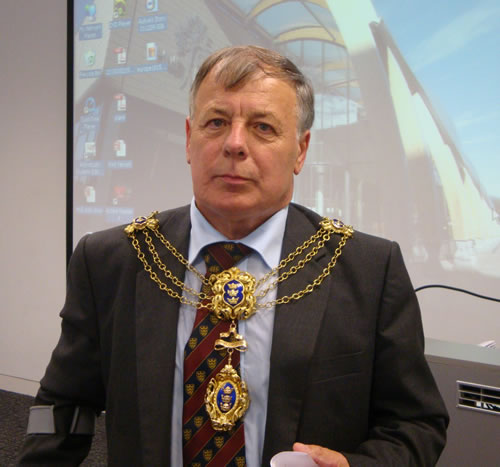 |
Martin Taylor, City Archivist, introduces delegates
to
the Hull History Centre |
The Lord Mayor of Hull welcomes
the Dalton Genealogical
Society |
In the evening there was an informal reception in the
Garden Suite followed by a buffet supper, which gave everyone the opportunity
to meet members of the committee and other delegates, and also view the
displays of Dalton family history charts, books, journals and other items
of interest. An enjoyable time was had by all, including a group of us,
who later on in the evening, took the opportunity to watch the Opening
Ceremony of the London 2012 Olympic Games in the hotel bar!
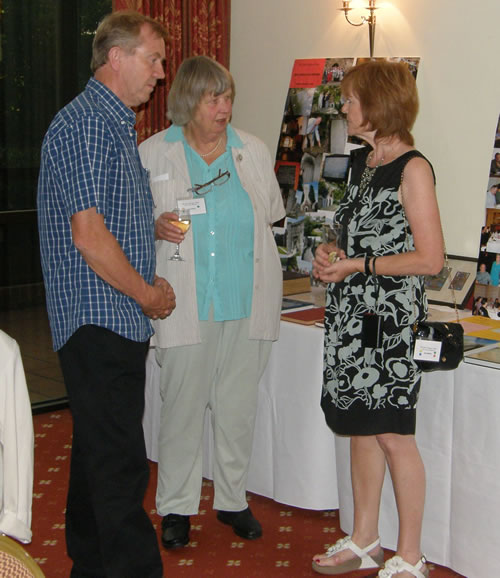 |
Howard and Jen Dalton meet Ann Clarke, a descendant
of the Dalton Mayors of Hull |
Saturday 28th July, 2012
The programme for the morning conference was scheduled
to start at 10.00 am and, with a very full morning planned I opened the
proceedings at 10.00 am precisely with our own "Opening Ceremony".
Although not on quite the same scale as what we had witnessed from the
Olympic Stadium the previous evening, it was nevertheless a great pleasure
to welcome all our delegates from far and wide, and the local ones too.
It was particularly pleasing to see representatives from the United States
(Jack Rudisail from Texas, a new DGS member), and from Australia, Maureen
of course, together with Wendy Fleming and John Prytherch. We were also
joined by a number of local Yorkshire Daltons, including Jim Dalton, with
his wife Julia, and their first cousins John Dalton and Ann Clarke, all
descended from the Dalton Mayors of Hull; David Dalton, with his wife
Barbara, from nearby Hessle and with Hull Dalton descent; Adrian Dalton,
with his wife Eve, from Poole, Dorset, but descended from Daltons from
the nearby village of Kilnwick; also sisters Doreen Skiven and Beryl Skiven-Baker
with Kilnwick Dalton connections. All of these were attending their first
DGS Gathering. Add to them, Howard our Gathering Organiser, and his wife
Jen and that completes the formidable group of delegates with Yorkshire
Dalton connections!
We then moved into the AGM and this will be reported
on fully next month with the minutes of the meeting. I will just mention
one thing here, the announcement of the DGS "Above and Beyond"
Annual Award. The committee have instituted this award, open to DGS members
who are not officers or committee members, to recognise exceptional contributions
to the work of the Society. The committee will nominate the recipient
each year and the award will normally be announced at the DGS Gathering
or AGM. I informed the meeting that the first recipient for 2012 would
be announced at the Annual Dinner.
With the AGM concluded soon after 11.00 am and following
a short break, we resumed for the two talks – the first being by
Howard on the Daltons of Garton-on-the-Wolds. Howard introduced his subject
with some geography and then took us through the history of Garton from
Roman times and speculated about the DNA that would have been introduced
into Garton families over successive centuries with the Romans, Saxons,
Vikings and then the French Normans being extant in the Yorkshire Wolds
at different times over the period. Woven into this was the more recent
documented history of his own Dalton descent from 18th century Dalton
blacksmiths who lived and worked in the village. The talk was much enjoyed
by us all and proved to be an excellent introduction to the visit to Garton
planned for Sunday afternoon.
Our final talk was given by Charlie Cradock, Education
Officer of the East Yorkshire Family History Society. I had invited Charlie
to introduce us to the sources for family history research in the East
Riding and in Hull. His talk, illustrated with online visits to many websites
and searching specifically for Dalton records, was something of a "tour
de force", and gave us all an insight into the many different
sources and archives available, much of it at our finger tips sitting
at our computer screens at home. The keen researchers amongst us all found
something new to explore in more detail later, and the video of Charlie’s
talk will be well worth a view by those who did not attend the Gathering.
1.00 pm came around all too quickly and I had to draw
the conference to a close. There was no doubt that much ground had been
covered during the morning. But we had to move on with a buffet lunch
to fortify us and then off to Beverley for the afternoon.
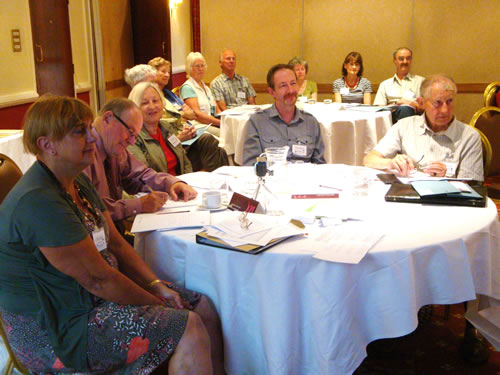 |
Delegates at our AGM and Conference |
Beverley Minster was the central attraction for the Saturday
afternoon and about 25 of us opted for the roof tour with its climb up
a very narrow and long spiral staircase to reach the roof space above
the minster. We were guided by the experienced and knowledgeable verger,
who ensured that we all reached the top safely. Exploring the roof space
was fascinating and the photographs you will find in the gallery give
a good impression of what we saw. The most amazing part of our tour was
when the circular boss above the nave altar was lifted so that we could
gaze down to the nave below. As we looked down, the distant Howard J looked
up!
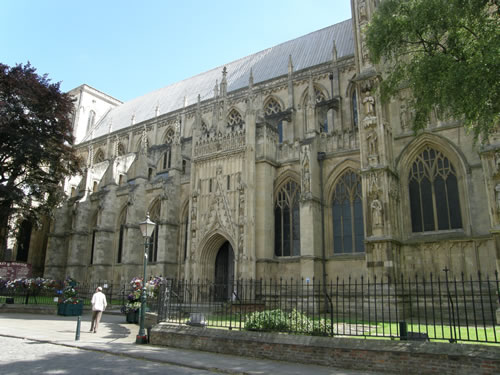 |
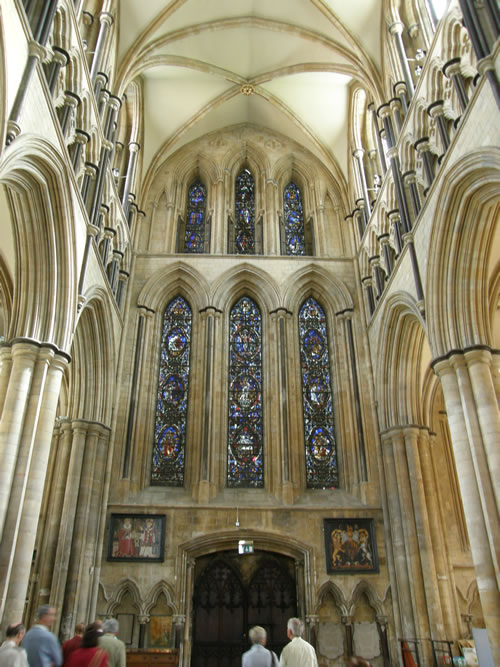 |
The North Door entrance to the Minster |
The West Door and Great West Window |
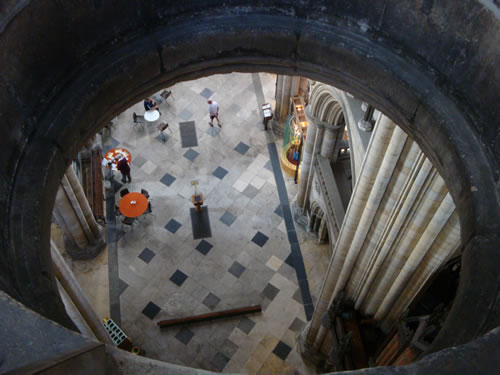 |
 |
Looking down onto the Nave from the roof |
Howard J Dalton looks up as we look down! |
Following the roof tour delegates went their own ways
to explore the narrow streets of the town and visit some of the delightful
shops. Others visited the Old Treasure House. Howard and Jen and Kate
and I elected to find one of the many old tea rooms and enjoy a quiet
cup of tea in delightful surroundings before returning to the hotel.
On Saturday evening, we held the main social event of
the weekend, our Annual DGS Dinner. This was preceded by a reception and
we were joined by Chris Pomery, our DNA consultant, who gave us a very
brief update on the Dalton International DNA Project. It was good that
Chris, just returned from a rather soggy camping holiday in Scotland,
was able to join us as a guest and many took the opportunity to discuss
DNA matters with him during the course of the evening. Dinner was served
and thanks go to Maureen and Pam for sorting out the menu choices and
seating plan. Everyone had a seat to sit at, and was served the correct
food; with the exception of the two David Daltons present, whose menu
choices had been reversed, but this was quickly sorted out!
Following the starter and the main course, I introduced
our entertainers "The
Spare Hands", led by Steve Gardham, who regaled us with
a wonderful selection of sea shanties and songs about the local sea-faring
community, many going back to the days when Hull was such an important
sea port and trading centre. Steve explained the work that his organisation,
the Yorkshire Garland Group, is doing making recordings for incorporation
into new exhibits at the Hull Maritime Museum. The DGS showed its appreciation
to Steve and his two colleagues with a collection of over £100 as
a contribution to their work.
After a break, the evening proceedings resumed with our
awards and presentations, followed by the raffle. The two main awards
were firstly to John, our Editor – I presented him with the framed
certificate from the Federation of Family History Societies for taking
second place in the One Name section of the Elizabeth Simpson Award for
best journals in 2011, together with a celebratory bottle. As has already
been reported this was a richly deserved award, originally presented to
the Society back in March, when John and I attended the Federation AGM
in London – many congratulations again, John! The second award was
for our newly instituted DGS "Above & Beyond" Award
and this went to Howard for all his work as Gathering Organiser, and as
a former Treasurer of the Society and gathering organiser in 1992 and
2002. Again, a very well deserved award and it was a pleasure to present
Howard with a celebratory bottle and promise him a certificate to mark
the award, just as soon as it has been designed and printed. We then had
some fun with fridge magnets – I had found some excellent ones with
phrases relevant to family history and family historians for distribution
to committee members and their long-suffering spouses, and these caused
considerable amusement.
The final part of the evening was the raffle, as usual
efficiently organised by Kate, which raised £116 for Breast Cancer
Care, the charity chosen by the committee to be the recipient of the proceeds.
I am grateful to committee members for supplying the considerable number
of prizes on offer, which added to the fun of the draw. With the conclusion
of the raffle the formal part of the evening came to a close, and many
enjoyed the opportunity for further informal conversations and another
drink or two.
Sunday 29th July, 2012
Sunday began at a more leisurely pace with plenty of
time for breakfast and a final look at the displays, before the scheduled
10.30 am departure to the centre of Hull. A number of us attended the
morning service at Holy Trinity Church, while others looked around the
city. At noon we all gathered in the church for coffee and biscuits, followed
by a fascinating tour, led by Jean Fenwick with her encyclopaedic knowledge
of the history of the church and its artefacts. Central to our visit was
of course the tombstone of Thomas Dalton, Mayor of Hull, who died in 1590,
but everyone was very struck with the beauty of the church with its painted
ceilings, wonderful stained glass and many other features. We are indebted
to Jean for such an interesting and full tour.
 |
 |
Holy Trinity Church, Hull - the Nave with its
painted
ceiling and the West Window |
Jean Fenwick, our guide points out a feature
inside
the church to Jim Dalton |
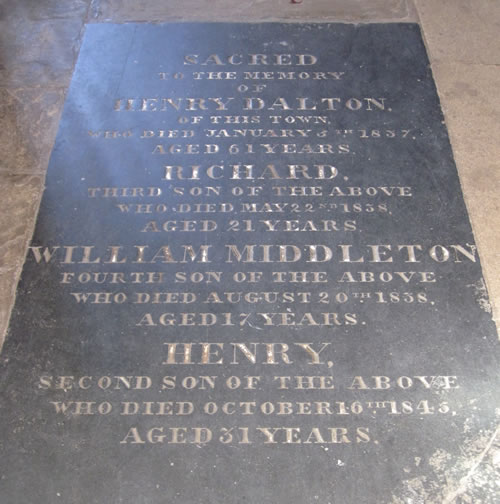 |
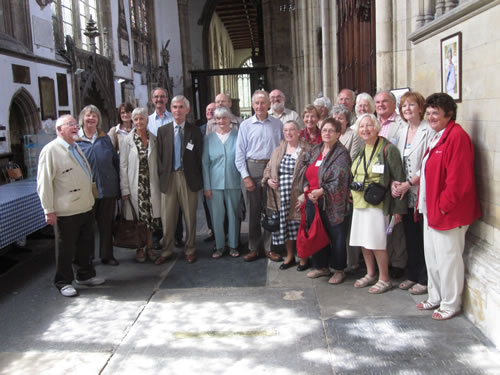 |
Tombstone in the south aisle of Henry Dalton of
Hull
who died in 1835 and three of his sons |
The DGS gathered around the tombstone of
Thomas Dalton, Mayor of Hull, who died in 1590 |
Following the tour of Holy Trinity we had time to find some lunch and
then departed for Garton. I gave Jack Rudisail a lift and enjoyed his
company for a little longer than planned – we were so engrossed
in conversation that I missed a turning and we ended up taking a delightful
tour of the byways rather than the highways in the Yorkshire Wolds. Fortunately
Jack enjoyed the experience – rather different from his home territory
in Texas! On arrival at Garton, others had already visited the Forge and
were gathered at the church, where the church warden had persuaded his
contractors to restore temporary lighting in the church so that we could
admire the wall paintings without having to resort to the torches we had
all been asked to bring. New flood lighting is currently being installed
inside to improve the illumination of the paintings. It was a most interesting
visit and all enjoyed seeing the inside of this wonderful church.
 |
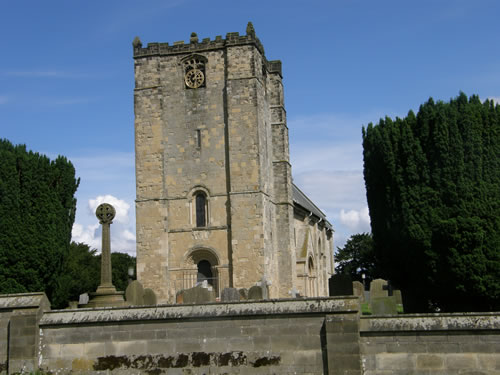 |
Garton Heritage Forge where today's Garton
blacksmiths
continue their traditional work |
St Michael and All Angels Church,
Garton-on-the-Wolds |
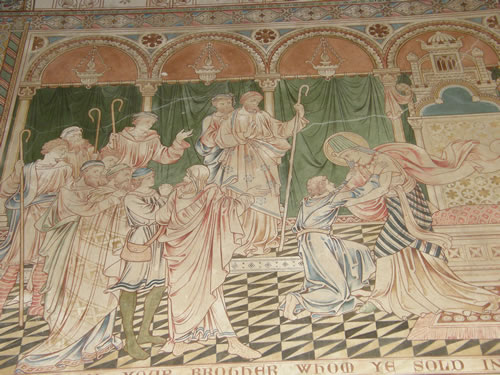 |
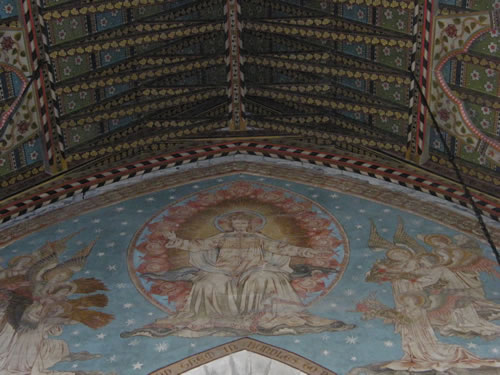 |
A detail from the wall paintings by Clayton and
Bell |
The painted walls and ceilings compete for your
attention |
 |
Looking through the richly carved wooden chancel
screen to the stained glass East window |
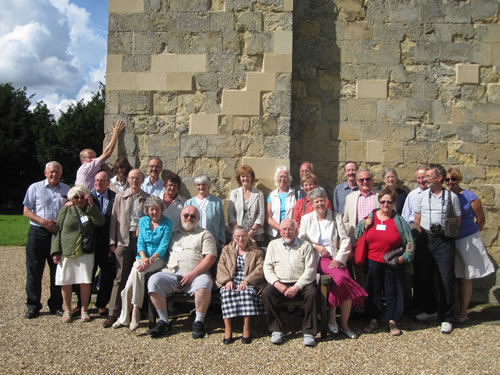 |
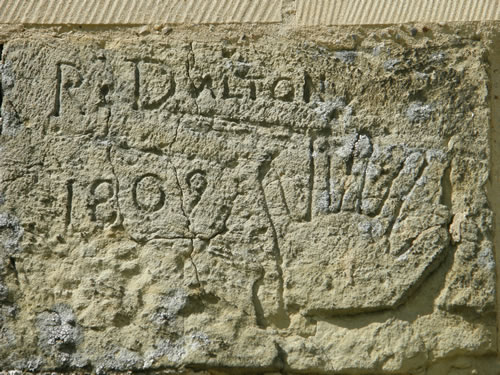 |
The DGS group assembled outside Garton Church
with
Howard pointing to the inscription and hand |
R Dalton 1809 and the imprint of hand
clearly carved
in the stonework for all to see |
Our final port of call in Garton was to see the relocated
hinges made by Robert Dalton in 1833 and now in West End Farm. The owners
had kindly invited delegates to visit their home and view these hinges
supporting two doors on opposite sides of the converted barn, now a splendid
dining room.
After Garton it was back to the hotel for a short break
and time to change before setting off again to go to South Dalton and
the Pipe & Glass Inn. Here we were welcomed by the owner of the inn,
James McKenzie. He and his wife took the Pipe & Glass over about six
years ago and have turned it into an award winning Michelin starred pub.
The conservatory had been reserved for our buffet supper, the final event
of the weekend and what an enjoyable and relaxed occasion it was. James
gave us a short account of the history of the inn and, after yet another
group photograph, we settled down for a most sumptuous supper and a further
opportunity to socialise and exchange information about our respective
Dalton family histories.
 |
 |
The DGS group with our host, James McKenzie
outside
the conservatory |
Maureen Collins and Pam Lynam meet up with
their
long lost second cousin, Barbara Watkinson |
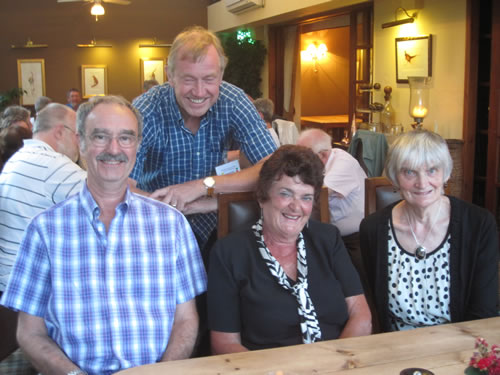 |
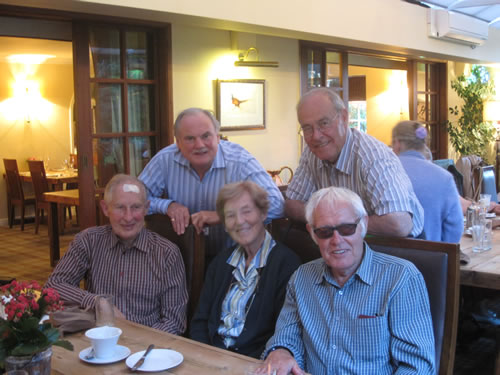 |
Adrian Dalton, Beryl Skiven-Baker and Doreen
Skiven,
who share Kilnwick Dalton connections, joined by Howard |
Michael Dalton, Robin Prytherch, Geoffrey &
Jane
Dalton, John Prytherch all sharing Welsh ancestry |
All too soon the evening came to an end, and it was time
to bid farewell to those not staying at the hotel. On returning to Willerby,
there was the opportunity for a final drink before retiring and reflecting
on a busy and action-packed weekend.
Monday 30th July, 2012
The day of departure and saying goodbye. Inevitably all
good things have to come to an end and I think all who attended agreed
that it had been a most successful weekend. I eventually departed from
Hull around lunchtime and, somewhat wearily, drove the 250 miles home
to Reigate. I went through torrential rain at several points as I travelled
south and reflected on how kind the English weather had been to us –
hardly a drop of rain for the Gathering and mainly quite warm with sunshine.
Weren’t we lucky?!
This has been something of a whirlwind "tour"
through the weekend – well the Gathering was something of a whirlwind
too, with so much to do and so many people to meet. Whilst I have been
writing, I have been interrupted by grandchildren staying with us, and
of course the Olympics and all the excitement that they have generated.
I therefore trust I am forgiven if I have left out anything of importance.
Inevitably this is a snapshot from my personal reminiscences. For
further photos please follow this
link. I look forward to all of you who attended filling the gaps
with the reminiscences that you have been asked to send in to Dairne in
good time for next month’s "Daltons in History".
Please don’t forget to do this. Do it now!! |
|
1. From Maureen Collins, DGS Secretary
Australia:
What a good time we all had thanks to Howard Dalton’s
wonderful organising with his wife Jen and with Michael.
I arrived on the Thursday evening at the hotel with Pam
and Dave Lynam, with whom I had spent two nights in their new home in
a lovely part of Cambridgeshire. The gathering virtually started an hour
later when we met up with Michael plus John and Sheila and Wendy Fleming
in the hotel bar for a light supper.
For once we managed to plough through a committee meeting
on Friday morning before lunch and the very interesting visit to History
House with its excellent research facilities and a talk on the historic
Hull Daltons in the 15th and 16th centuries. By that evening many other
delegates had arrived and were made welcome.
The meeting on Saturday morning ran smoothly and it was
followed by one of the highlights for me: Howard’s highly original
talk on Garton on the Wolds, illustrated by photos. The presentation by
Charlie Cradock was also excellent and a surprise when Howard J and I
found we were both researching the same family in Hull that Charlie spoke
about.
The final highlight for Pam Lynam and me was meeting
our cousin, DGS member Barbara Watkinson, for the first time ever at the
Pipe and glass Inn. Barbara has been doing some wonderful research into
our family in Hull but somehow over the years we had never actually met.
All in all it was a top-class week-end and I imagine
a lot of ideas for research will come from it while we wait another year
for the next meeting.
2. From Wendy Fleming, Australia:
Having just finished the required reading for this Gathering,
A Selection of Articles, Ed Michael Neale Dalton, I now feel
sufficiently informed to write a personal account on the event.
The City of Hull 154 miles from London, whose main industries
are fishing in the North Sea, chemical and pharmaceutical industries,
and fish and chips, has a remarkable history which entitles it to display
three crowns as its crest. It is also a city in which Daltons played a
part in the commercial and civic life of the city during the 15th and
16th Centuries, and of more recent times blacksmithing — a most
suitable place for DGS Gathering.
The Hull Mecure hotel, 5 miles from Hull, formerly Grange
Park Hotel, Willerby, is in a cul de sac off a major road, nestled in
a wooded location. With many rooms and function facilities, (constantly
in use for weddings), lawns, gardens and free Wi-Fi in the foyer, it proved
to be a user friendly centre for our activities. In particular we found
the foyer a very pleasant meeting place for relaxation. On Friday night
we gathered there to vicariously share the excitement of the opening ceremony
of the Olympic Games. The central theme of England’s industrial
might and subsequent demise was particularly resonant with me after seeing
an abandoned coal mine, complete with silent windlasses and conveyers,
on my train trip through the midlands.
At the AGM on Saturday, Howard Dalton, main speaker
and descendant of the blacksmiths, speaking of his family from Garton-on-the-Wolds,
set a laid-back friendly tone which was to characterise the whole weekend.
Authenticity was given to our group by the presence of a number of descendants
of Howard’s line, and direct descendants of the Mayors of Hull.
It was a pleasure to meet up again with members of the DGS, Chairman Michael
and Kate, DNA cousin, Mike Dalton and his wife Kate from Norfolk, Maureen
Collins and John Prytherch also from Australia, and new US member Jack
Rubiso from Texas.
The packed program actually began on Friday afternoon
at the purpose built (courtesy of the National lottery Heritage fund)
Hull History Museum, where we were met by the present mayor of Hull wearing
a chain which included some gold from the chain originally worn by Robert
Dalton 15th C Mayor.
Then Helen Good a local historian introduced us to intriguing
issues about the Dalton Mayors of Hull, such as their acceptance as merchants,
but exclusion as marriage partners for other merchants and their children.
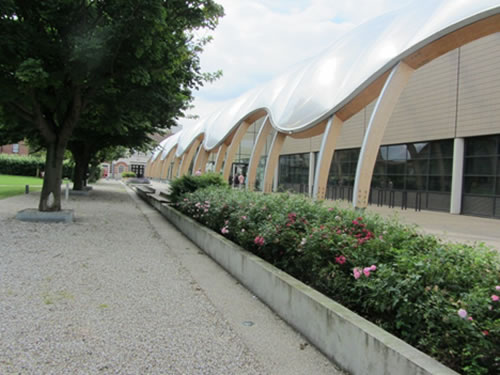 |
Hull History Centre |
Meeting and Dinner
Our meeting on Saturday and the dinner was a pleasant
occasion with a raffle, special prizes from Chair, and wonderful entertainment
by "The Spare Hands" who performed, singing sea shanties
to raise money for the Yorkshire Garland Group.
Then it was churches, what a holy lot the Yorkshire people
must be. On Saturday in between the AGM and Annual Dinner found us in
the imposing Beverley Minster, climbing 113 steps in the spiral staircase
to enjoy the Roof Tour. In a workroom many metres high above the altar
we learnt how the workman, by means of a horse powered wheel, brought
up building supplies from many metres below to complete the roofing. The
size of beams and logs used in the construction was an indication of how
hard it was for the horse and laborers.
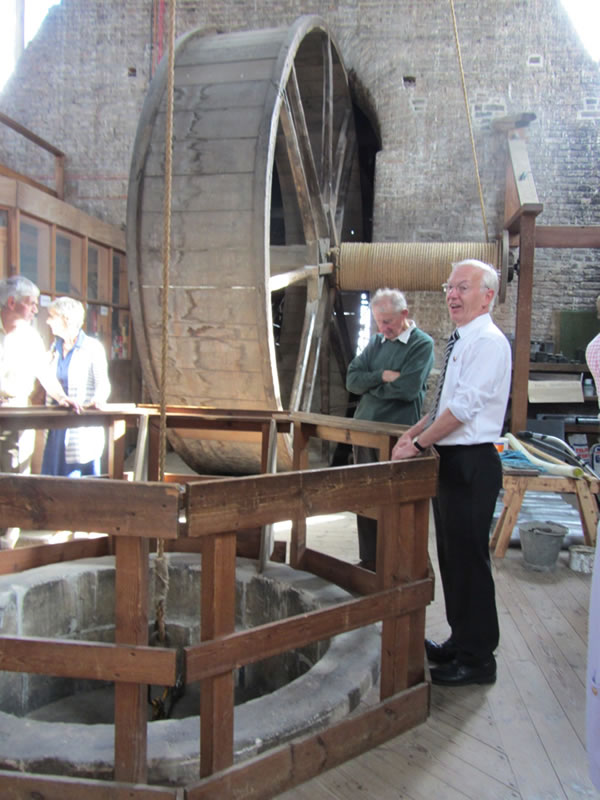 |
Horse powered wheel |
Sunday morning we visited England’s largest parish
church, Holy Trinity, which is full of extraordinarily rich architecture
and memorials to past and modern events all of which are well documented
and photographed by other members of the party. I was intrigued to find
among the many fine wood carvings some unusual creatures carved on the
arms of the pews.
 |
 |
Pew carving in Holy Trinity Church |
More pew carving |
And then I found there is an Australian connection. George
Henry Peck, born 1810 in Hull, painter, carver, art dealer, art entrepreneur
and musician, emigrated to Hobart Town in June 1833. In 1837 he arranged
the first general art exhibition held in any of the Australian colonies.
He returned to Hull and lived there for a short period in 1841 when it
is reported he carved these decorations. He returned to Australia and
died in Sydney in 1863. So far I cannot find a Dalton connection but I
will continue to look.
Sunday, still in progress, we made our way across country
for the visit St Michael & All Angels church at Gorton-on-the-Wolds.
A beautiful church which occupies a site on which there has been a church
since the 12th Century, it is in the process of restoring Victorian wall
paintings. The Dalton connection was a carved name R Dalton 1809 and a
hand print on the outside all evidence of Howard’s ancestor, the
blacksmith. Further evidence we were able to see was the signed door hinges
at West End farm. The restoration of this farm house would send Kevin
McLeod into raptures . A model of how to blend the new and old with careful
integration of historical items, such as the door hinges, it seems an
extremely liveable home. We were very grateful to the owners for allowing
us to visit.
A fresh informal dinner at The Pipe and Glass at South
Dalton ended a very successful Gathering. Next morning we went our separate
ways. I went with Maureen to Hull History Centre where she and Howard
J searched the archives for family connections which they excitedly found.
I meanwhile read letters sent over a forty year period, by Philip Larkin
to his friend and lover Monica Jones. At the railway station I said goodbye
to Maureen , Howard J and Philip Larkin.
My thanks to Michael Neale Dalton and Howard Dalton
for their careful planning which ensured a really interesting Gathering,
to all my fellow attendees who got into the mood and made it such a sociable
occasion, to the City of Hull for fish and chips, and friendliness.
A special thanks to Maureen Collins, Mike and Kate Dalton
who provided my transport.
3. David and Barbara Dalton, Yorkshire, England
Our curiosity about the impending DGS Gathering in our
locality was aroused by a small item in the Hull Mail. We contacted Howard,
who assured us that we would enjoy the event, but we were still a little
unsure about what to expect. As it turned out we thoroughly enjoyed taking
part. We were welcomed most warmly and made to feel very much part of
the group. Obviously Michael, Howard and the Committee had put a lot of
hard work into organising the weekend, doing the groundwork and ensuring
everything ran smoothly.
It was interesting to visit places we know well but to
view them from a different perspective. We were surprised to learn of
the extent of the influence the Daltons have had in the history of Hull,
and Howard’s research involving local history gave us food for thought.
Possibly being a Parisi sounds rather grand! We enjoyed seeing his blacksmith
ancestor’s hand carved high up on the church wall (he must have
been very tall!), and all of us trooping through the barn conversion to
view the hinges forged by the same hand.
Other highlights included the Annual Dinner with the
entertaining local ‘turn', "The Spare Hands",
and rounding off the weekend at the appropriately named South Dalton with
a splendid buffet meal at The Pipe and Glass.
We hope that everyone enjoyed visiting our patch and
trust that they may be encouraged to come again to explore more or the
Hull Old Town and other attractions in the East Riding area.
4. From Ann Clarke, Ripon, Yorkshire, England:
Thank you very much indeed to you, Howard and other committee
members for an interesting, enjoyable and extremely well organised weekend
in Hull. It must have taken a great deal of work and energy to accomplish.
The whole atmosphere was most relaxed and friendly and it was good to
meet other Daltons and to hear more about the Society. I was only sorry
that time pressed so much on Sunday that there was no time to say a proper
goodbye to everyone, but I hope you all enjoyed the visits to Garton-on-the-Wolds
and your meal at the Pipe and Glass.
5. From Jack Rudisail, Texas, USA:
Really enjoyed the reunion. Keep in touch. Hoping to
make it to Dublin next year.
6. From Steve Gardham of "The Spare
Hands"
In response to my thank you note for the entertainment
by "The Spare Hands" after dinner on the Saturday evening,
Steve writes:
"The amount you raised for the Yorkshire Garland
Group’s work with the Hull Maritime Museum was £115 so we
are well pleased with that. Many thanks for contributing to the project.
I will have a look at the website and video and will send on your message
to the others".
7. From Howard J Dalton, Poole, Dorset, England:
It was a most excellent weekend enjoyed by all and in
excellent company, and Howard and yourself provided a feast of events.
Thank you again for the fridge magnet. I have now acquired a small collection
of them!
8. From Robin Prytherch, Bristol, North Somerset,
England:
Both John (Robin’s brother from Australia) and
I thoroughly enjoyed the Gathering in Yorkshire - great fun and interesting.
9. From Kate Dalton, Reigate, Surrey, England:
A very enjoyable weekend and it was a pleasure to organise
the raffle on the Saturday evening. I was delighted to collect a total
of £116 to donate to Breast Cancer Care, a very worthy charity that
does such valuable work. It was particularly pleasing to see the generosity
of everyone, particularly bearing in mind that you had already dipped
your hands into your pockets for the "Spare Hands"
to support their work with the Hull Maritime Museum, another worthwhile
cause. Thank you to you all and to those who donated the raffle prizes
– there were so many of them, and they just seemed to go on and
on!
10. From Jim & Julia Dalton, Ripon, North
Yorkshire, England:
We greatly enjoyed the weekend, particularly Helen Good's
talk and the visit to Holy Trinity.
11. Howard Dalton, Thornton Dale, North Yorkshire,
England:
"I was delighted when the DGS chose Yorkshire,
and in particular Hull, for their Gathering in 2012, but then to be asked
by MND to help with the organising was an even greater honour.
There were so many highlights it would be unfair
to single one out in particular, but mention has to be made of the visit
to Beverley on the Saturday afternoon. Many members climbed up into the
central tower and the guide lifted one of the huge ceiling bosses that
gives access to the Nave below. Almost on cue Howard J appeared below
and we all called down to him, though he couldn't see us. He later recalled
that when he heard his name being called from above, he thought he was
being summoned from on high, which he was!!
All the arrangements that MND and I had made worked
out superbly and thanks have to go to all the parties we worked with;
Martin at Hull History Centre, Helen Good, "Spare Hands", Jean
at Holy Trinity and James at the Pipe and Glass, to name but a few. The
main thanks, however, have to go to all the members who attended that
weekend, and as I have said in the past, the variety of personalities
make these Gatherings such memorable occasions".
12. Mike and Kate Dalton, Thetford, Norfolk,
England:
The main impression Kate and I came away with this year
was of a very relaxed atmosphere. The annual Gathering is always a very
friendly affair with the opportunity to meet new Daltons and catch up
with old friends but this one stood out as being more close-knit. Perhaps
it was the impromptu occupation by Daltons of the hotel bar to watch the
Olympic opening ceremony or the way we all squeezed into a few cars for
the visits which mixed and matched folk up nicely or maybe the wonderful
pub in South Dalton where we were looked after so well for our meal on
the Sunday evening. Whatever it was, for us, it added a gloss to the weekend
over and above the usual superb planning and organisation which goes into
every Gathering.
Another abiding memory is the tremendous surprise, when visiting Beverley
Minster, of discovering that the climb to the roof was not, as anticipated,
to see the view from the parapet but was actually - a visit to the roof!
A fascinating insight to a hidden gem. The structure itself was impressive,
as was expected, but to find a fully working man-powered treadmill which
then operated a floor hatch allowing us to "cooee" like schoolkids
at the people below... well I think a few folk felt rather god like at
that moment, gazing down a looong way to the Minster floor and the mystified
people below wondering from where the ethereal heavenly voices were emanating.
For me the highlight was finding, engraved on the roof gable window, sketches
of various aeroplanes. Unfortunately my camera refused to focus on them
and insisted on looking at the scenery beyond. Who says computers are
clever! A very successful trip indeed.
|
|
Annual Gathering for 2012
Friday 27th to Monday 30th July, 2012
Hull, Yorkshire, England
PROGRAMME FOR THE WEEKEND
Friday 27th July 2012
| from 12 noon |
Check in at the Mecure Hull
West Hotel and register at the DGS desk
in reception. Light lunches can be taken at the Hotel. |
| afternoon |
Visit to the Hull History Centre
in the centre of Hull, where there will be an official welcome to
the DGS by the Mayor of Hull and afternoon tea will be served. Archivist,
Martin Taylor, will introduce us to this state
of the art centre and its contents. Then Helen Good,
a noted local historian, will talk to us about 16th Century
Dalton Mayors of Hull. Her talk will be illustrated with
documents held in the Centre’s archives. |
evening |
We return to the Hotel for an
informal buffet supper in the Garden Suite,
and the opportunity to meet other delegates and look at Dalton family
history displays. |
Saturday 28th July 2012
|
morning |
The programme will commence with
the DGS Annual General Meeting. This will be followed
by talks about Dalton family history and the work
of the Society. It will take place in the Garden Suite
at the Hotel.
Buffet lunch served in the Garden
Suite. |
|
afternoon |
A visit to Beverley is planned
with the opportunity to explore Beverley Minster
and the Beverley Record Office. There will also
be free time to enjoy the delightful streets and shops in this historic
town. |
evening |
The DGS Annual Dinner will take
place in the Garden Suite at the Hotel and it will
be followed by entertainment. |
Sunday 29th July 2012
|
morning |
We return to the centre of Hull
to visit Holy Trinity Church, where Daltons are
buried. Time will be available for further exploring of Hull city
centre and a light lunch.
|
| afternoon |
We will travel to Garton-on-the-Wolds,
the home of one of a number of Yorkshire Dalton families. This will
include the opportunity to see the magnificent and historic church
in the village with its wall paintings. |
|
evening |
En route back to the hotel we will stop in the
village of South Dalton for an informal
supper at the much acclaimed Pipe and Glass Inn,
where our hosts will be James & Kate McKenzie, winners of the
Michelin Pub of the Year 2012 award. |
Monday 30th July 2012
|
morning |
The conclusion of the DGS
Gathering. Check out from your accommodation. Arrangements
can be made for those who wish to stay over. |
|
This article was originally written in 1970 by the then
editor of the DGS Journal and now Chairman of the Society Michael Dalton, and
published in Volume 1 of the DGS Journal. It is being republished here as the
first of a series of articles taking Yorkshire Daltons as its theme, and particularly
Daltons of Hull and the Daltons who were Mayors of Hull in the 15th and 16th
centuries. This article contains details of these early Yorkshire Daltons and
their descendants. The original article was prepared in consultation with the
late Major-General Sir Charles Dalton who is one of these descendants.
In order to provide sufficient background to the contents
of this article, which is really a progress report, it is necessary to
give a brief summary of the structure of the Pedigree of the Dalton family
beginning with Sir Rychard Dalton of Byspham in Lancashyre, Knight, who
was born circa 1230 AD. Sir Rychard is the earliest Dalton recorded in
the official records of the College of Arms. The information shown in
Chart I is extracted from the Visitation of Yorkshire in 1563-4 by William
Flower, Norroy King at Arms, as printed in the Harleian Society Publications
Volume XVI pp 84-89. It shows the connection between the Daltons of Thurnham
and what is commonly known as the Junior Dalton Line, from which John
Dalton (1780-1851), who married Hannah Neale, is descended.
Amongst the descendants in the Junior Dalton Line is
a large family resident in the United States of America. The forebear
of these American Daltons emigrated across the Atlantic before the American
War of Independence in 1775-6 and a certain Mark Ardath Dalton of Long
Beach, California, who is a seventh cousin of the Editor’s father,
has compiled an extensive genealogy of this branch of the family. In his
book “The John Dalton Book of Genealogy”, published by the
Dalton Family Organisation in 1964, he gives an account of the family
history right back to the Sir Rychard mentioned above. The information
for this section of his book was, in the main, collected by one of his
family, who visited England in the 1860s and again in the 1880s. Included
in his details of the earlier part of the pedigree is the statement that
the Daltons of Yorkshire described below are descended from John Dalton,
the third son of Robert of Bispayne who married Margaret and was born
circa 1400 (ref p3, John Dalton Book of Genealogy).
Chart II shows the pedigree of the Daltons of Hawkeswell
and the Daltons of Sleningford in outline. The records of this family
are held by the College of Arms right back to John Dalton of Kingston
upon Hull who died 10th September 1458. It is known that John Dalton had
an elder brother William who was "co-executor of his brother John’s
will with his widow, Joan". The proposition (or hypothesis)
is that this John Dalton of Kingston upon Hull is one and the same person
as John Dalton, third son of Robert of Bispayne.
In January 1969, the Editor put this proposition to Major-General
Sir Charles Dalton of the Yorkshire family with whom he had been in contact
for some months. Sir Charles and the Editor had been investigating the
possibility of a link between their families being lost somewhere in the
haze of the 15th century and this suggestion, originating from Mark Ardath
Dalton’s book, was the first really plausible hypothesis. Sir Charles’s
reaction was one of cautious enthusiasm. On the one hand, there was the
distinct possibility of his pedigree being extended back through five
generations to Sir Rychard of Byspham; on the other hand, nothing had
been proved, all was supposition with a considerable amount of plausible
supporting evidence. Sir Charles and his brother, Major-General John Dalton
of Hauxwell Hall, after obtaining the opinion of Mr J P Brooke-Little,
Richmond Herald at the College of Arms, decided to ask the College to
undertake the necessary research either to prove or to disprove the theory
put forward. This work is now being done by the Richmond Herald’s
genealogist, Miss Colwell.
Amongst the plausible supporting evidence are the following
interesting facts. It cannot be emphasised too clearly that what follows
does not constitute any sort of proof of the theory.
(i) It seems that Robert Dalton of Bispayne married Margaret
about 1420 and that his three sons, Rychard, William and John were born
between 1420 and 1425. This means that John would have been in his thirties
when he died in 1458 which fits in well with the fact that his wife Joan
married a second and a third time.
(ii) There are heraldic similarities between the two
families. The arms and crest of the Dalton of Thurnham Line are as follows:
Arms: Azure, semee of cross-crosslets or, a lion rampant,
guardant, argent
Crest: A dragon’s head couped vert, between two
wings or,
Those of Dalton of Hawkeswell are described thus:
Arms: Azure, semee of cross-crosslets or, a lion rampant,
guardant, argent, a chief barry nebulee of three of the last and sable
Crest: A dragon’s head with wings displayed vert,
the outside of the wings or, gorged with a collar nebulee of the last.
The Dalton of Thurnham Arms and Crest are those used
at the beginning of this Journal. Those of Dalton of Hawkeswell are similar
with what are known as "differences". In heraldry, in order
to distinguish between the senior line of a family and the line of a second
or subsequent son, the arms granted to the junior line are, to use a technical
expression, "differenced". Here we have the addition of a chief
barry nebulee to the arms and a collar nebulee to the crest. This fits
in with John Dalton being third son of Robert.
Regrettably the work of Miss Colwell has yet to establish
the validity or otherwise of the link put forward. There have been two
progress reports on the research so far and her findings have served to
confuse rather than clarify the situation. Searching of Wills, Chancery
Proceedings and other documentation available in London and in Hull has
produced a mass of information, including the complication of there apparently
being not one but two Dalton families extant in Hull in the 15th century.
However, conclusive proof or evidence to disprove has yet to be found.
Major-General Sir Charles is continuing to support the work of Miss Colwell
so that she can follow up various leads as yet unexplored but the present
situation leads one to believe that it is unlikely that evidence of the
kind required is in existence today.
It was stated at the beginning of this article that it
would be a progress report. It is hoped that, by the time the Volume of
this Journal for 1971 is published, there will be a final report available
from the College of Arms.
Sadly, the further work undertaken by Miss Stella
Colwell did not result in any changes to her conclusions and therefore
the link remains unproved to this day. It should also be pointed out that
the link between the Junior Dalton Line and the Daltons of Thurnham is
not proved – this has been the subject of a series of articles in
the DGS Journal by the late Dick Hamilton (see DGSJ Vols 14, 15 &
16).
CHART I – Sir Rychard Dalton of Byspham
in Lancashyre, and his descendants

CHART II – Pedigree of the Yorkshire Daltons in outline
(Daltons of Hawkeswell and Daltons of Sleningford)

This article originally appeared in the DGS Journal Volume
11 Number 1 published in July 1982. It was written by the then editor of the
DGS Journal and now Chairman of the Society Michael Dalton. It is being republished
here as the second of a series of articles taking Yorkshire Daltons as its theme,
and these include Daltons of Garton-on-the-Wolds, a small village which we visited
during the gathering on Sunday afternoon. The 2012 DGS Gathering Organiser is
Howard Dalton, a descendant of the Daltons of Garton-on-the-Wolds and the organiser
of the Dalton Jamboree in 1982.
Unbeknown to the DGS and equally without knowledge of
the DGS, a Dalton genealogical event took place at Garton-on-the-Wolds,
East Yorkshire on 9th May last. This came about through the enterprise
of Howard Dalton from Northumberland who it turns out is descended from
the same John Dalton of Garton-on-the-Wolds as DGS members Mark Dalton
and Dr Antony Cox (see DGSJ Vol 10 No 1 pp 12-14 and MN&Q 10.10 &
11.6). Howard was interviewed on BBC Radio 4’s Today Programme on
the Friday morning preceding the Sunday of the event and one of those
who heard the interview was Mark. He arranged to attend and so the DGS
was not unrepresented! The account of the event given below appeared in
the Yorkshire Post on Monday 10th May as a ‘Weekend People’
feature:
Keith Nicholson attends the first gathering of some
of the descendants of an 18th Century Yorkshire blacksmith.
FORGING A FAMILY LINK
Nearly 30 descendants of an 18th Century blacksmith
made a pilgrimage yesterday to his East Yorkshire village.
At Garton-on-the-Wolds, near Driffield, they saw
the site of the old forge, long since demolished and now part of a garden,
where generations of Daltons worked.
On Saturday, the 20th Century members of the family
had gathered in York for their first reunion and self-styled “Dalton
Jamboree”. Some met for the first time at a dinner at Naburn Banqueting
Hall, near York.
The gathering was organised by Howard Dalton, a 32
year old accountant, of Cresswell, near Morpeth, Northumberland, who with
the help of others has traced the family history back nearly two centuries.
Mr Dalton carried out much of his earlier research
into parish records and census forms with his late father Mr Eric Dalton,
an organist at Dringhouses Parish Church, York, who died ten years ago.
Among those wearing “Dalton Jamboree 1982”
badges during the weekend were Reg Dalton, 70, of Cossington, Leicestershire,
his son, Jim from Carlisle, and his brother Professor Godfrey Dalton,
of Queen’s University, Belfast. Reg and Godfrey are uncles of Howard
Dalton, who had the badges made.
Professor Dalton was accompanied by his wife, Hilary,
and their children, Margaret, 26, Elizabeth, 23, and Nigel, 17, who swims
for Ulster.
The Dalton connection with Garton dates from the
days when John Dalton arrived in the village in the 1700s to take over
the smithy. It was passed down from father to son and the last Dalton
to be blacksmith there, Robert, achieved fame through his habit of putting
his name on nearly everything he made.
Howard Dalton yesterday pointed out Robert’s
signature carved on the tower wall of the village church in 1809, together
with the imprint of his hand. Family sleuths then went in search of a
barn door hinge, also said to bear Robert Dalton’s name.
Another branch of the family was represented by Mr
Mark Dalton, 32, of Kirkwood Way, Cookridge, Leeds, who can also trace
his ancestry back to the 18th Century blacksmith, John.
Mark had travelled to Garton with his brother, Andrew,
who played cricket for Yorkshire from 1970 to 1972 and is now the managing
director of a Leeds printing firm.
Howard explained that the reunion was suggested during
a visit to his aunt, Mrs Rene Whiteman, of Bridlington, who has helped
with research.
He added: “Although John Dalton’s first
child was born three months before he married a local girl, I haven’t
found any family scandal. Apart from blacksmiths, they were farmers and
policemen – and not surprisingly, they seem to have been very law-abiding.”
Howard Dalton has become a member of the DGS and the
publicity given to the Dalton Jamboree has brought about a number of enquiries
from Daltons in various parts of the country. Howard has kindly referred
these to the DGS and this has resulted in several new members for the
Society.
It is hoped that more details of the descendants of the
Garton-on-the-Wolds Daltons will be published in a future issue of the
Journal. They certainly have a formidable team of enthusiastic genealogical
researchers!
This article originally appeared in Volume 5 of the DGS
Journal published in 1974. It was written by the late Major General John Cecil
D’Arcy Dalton and tells the story of his Yorkshire Dalton family descending
from Daltons living in Kingston-upon-Hull in the middle of the 15th Century.
The Gathering took Yorkshire Daltons as its theme, and these included this Hull
based Dalton family, who were Mayors of Hull in the 16th Century and were the
subject of a talk by Helen Good at the Hull History Centre on the Friday afternoon.
1. Kingston-upon-Hull
Whether or not there is a link between the Thurnham and
the Yorkshire Dalton families (and the evidence is very strong even if
proof is lacking), there is no doubt that the Daltons were well established
in Kingston-upon-Hull by the middle of the fifteenth century.
The family were merchants of the staple (the staplers
traded in wool and had their chief office at Calais) and must have been
both prominent and prosperous, for as early as 1487, John Dalton was elected
Mayor. The city had been founded in the reign of Edward I and the first
Mayor was appointed in 1322.
All through the sixteenth century the family kept on
producing the Chief Citizen, several of them serving twice or thrice over
a period of years, often holding the office of Sheriff before being elected
Mayor. One of them, Thomas, an Alderman and Merchant, was also very holy.
By his will dated 1497 (the year Cabot sailed to Newfoundland and Labrador)
he founded a Chantry in Holy Trinity Church. He also left his house near
the church to the table-priests and their successors, and gave them his
"great picture of beyond sea work which cost him 8 pounds sterling
to set up over the Altar of St Corpus Christi in the Church".
And he asked to be buried on the north side of the aisle.
The family’s activities as Mayor, however, were
not always plain sailing. In 1540, King Henry VIII visited Hull on his
way to meet his nephew, James V of Scotland, at York and, after being
suitably entertained he left for that city. Meanwhile the election for
Mayor was due, and the candidates were Mr Dalton and Mr Johnson. Alas!
Before the votes were cast the King unexpectedly returned; the election
was postponed and the candidates went to meet him. When he heard about
the election, Henry ordered the Corporation to meet again and mentioned
that Sir John Eland should be nominated along with the other two. At the
election, the King voted for Sir John, and of course the latter was elected.
I suspect that democracy was but skin-deep in those days, and in any case
it was discreet not to thwart a Tudor monarch.
Another Dalton, Thomas, during the first of his three
mayoralties, was in office in 1554 when a rich citizen called Sir William
Knowles presented the Corporation with a gold chain weighing 4½
ounces upon condition that the Mayor should wear it every Sunday, holiday
and on particular occasions or else forfeit 40 pence for every omission.
This story has a sequel. The chain, presumably first worn by Thomas Dalton
in 1554, is still the basis of the chain worn by contemporary Lord Mayors
of Hull, and was worn when the writer, 10th in descent from Thomas, during
his year as High Sheriff of Yorkshire, entertained the Lord Mayor of Hull
to luncheon at the Assizes.
The last Dalton to be Mayor, in 1588, was Robert and
I am sorry to say he brought discredit on the family. He was accused later
of having "ingrossed most of the mills in his hands, taking (instead
of money) moultercorn, and more of it than he should, and aggravated his
offence by mixing plaster with it to increase the weight". For
this grave offence he was "severely reprehended" and
might well have been fined too had he not apologised and promised never
to repeat the crime. Honesty compels me to record this blot; family pride
makes me add that the culprit was not a direct ancestor of the present
Dalton line!
By the end of the sixteenth century the family was ready
to expand its life away from the channels of commerce. For some time they
had married into the families of the landed gentry, and had been well
educated. In particular, William Dalton, second son of that Thomas who
had three times been Mayor, became a lawyer and was Recorder of Hull.
He then moved and settled at or near Otley in the West Riding of Yorkshire.
He was made a member of the Council of the North at York, was subsequently
(in the language of the period) Attorney-General of the Northern Court
– which probably meant Secretary to the Council in modern terms
– and became also Recorder of York. His office was at King’s
Manor in York, which is still in existence and is now part of York University.
He was knighted by King Charles I at Whitehall Palace in 1629. A few years
later we find his signature on a letter from the Council to the Mayor
and Aldermen of Hull about the fortifications of the town and the payment
for them. I hope it gave him satisfaction to take some part in the affairs
of his native place. It is not known when he was born, but he died in
1649, a staunch but doubtless saddened Royalist, and was buried in York
Minster. There is a portrait of him as an old man at Hauxwell Hall. It
was in 1631 that he had bought Hauxwell for his son John, of whom more
in a moment.
Before finally leaving Hull, it may be of interest to
quote from an eighteenth century history of the town concerning the duties
of Mayor in the earliest days, to show that the holders of that office
were persons of consequence and had heavy responsibilities.
During his year of office he is to see the laws executed,
and the King within his district exercises his authority by the Mayor’s
administration, so that he is the King’s Lieutenant in his absence.
The Mayor of Hull gives place and drops the insiginia of authority only
to the Sovereign himself or the presumptive heir to the Crown, in the
presence of whom only he is dispossessed and on such occasions carries
himself the mace before the King.
2. Hauxwell
The manors of East and West Hauxwell and of Barden in
Yorkshire belonged after the Conquest to Earl Alan of Richmond and his
brother. They descended through various families over the years and early
in the seventeenth century were possessed by the Jopsons. From this family
they were acquired in 1631 by Sir William Dalton for his son John, who
thus became "First of Hauxwell" for our family. John
had married Dorothy D’Arcy of Hornby Castle near Bedale and only
three miles from Hauxwell. The house at this date was small and simple
and John was perhaps some sort of agent for the D’Arcys. He was
certainly "of their party" politically and shortly
became second-in-command of his brother-in-law’s troop of Royalist
horse. Several pieces of armour of the period are still to be seen in
the museum at Hauxwell. The family’s Hull origins were kept in mind
by the inclusion in a window of Hauxwell Church of an heraldic shield
of sixteenth century painted glass depicting Dalton impaling Tyrwhitt.
Ann Tyrwhitt had been the second wife of Thomas Dalton of Hull and was
John Dalton’s grandmother.
Whatever plans John, with his wife Dorothy, may have
had as squire of Hauxwell, were shattered by the Civil War. John took
service with his brother-in-law D’Arcy and in 1643 they were assigned
the duty of escorting the Queen, Henrietta Maria, on her journey across
England. The Queen had landed at Bridlington on the Yorkshire coast in
February, and after a delay in York began the hazardous cross-country
journey to join the King at Oxford. She arrived there in July, but regrettably
John Dalton was no longer with her. At the crossing of the River Trent
at Burton there was a skirmish with the Parliamentarian troops; John was
badly wounded. He was taken back to Yorkshire, where he died a year later
and was buried in York Minster. This melancholy event was recorded by
his father, Sir William, in his own handwriting on one of the fly-leaves
of his law manual (still at Hauxwell):
My only sonne John Dalton was wounded at Burton upon
Trent the fift of July 1643 and thereof dyed 1644 the 24 or XXVth July
who was a valiant man and a duetyfull and loving sonne.
Would not any of us be satisfied with such a simple and
moving epitaph?
One can imagine the disruption and distress caused by
the Civil War, with allegiance divided even within families. Yet things
soon returned to normal, and after his restoration, Charles II now King
remembered those whose families had loyally supported his parents. John’s
son William was one of those knighted by Charles II. This second Sir William
lived at Hauxwell and before he died had begun to enlarge the house. So
far as is known, no celebrated architect was employed, but the work attributed
to this period is typically restrained and eminently suitable for a squire’s
house.
The Daltons continued in the male line all through the
eighteenth century when their most important member was Sir Charles, younger
son of the second Sir William. He had been born in 1660 and in middle
life obtained some minor appointment as an Usher at the Court in London.
Here he mixed with fashionable and cosmopolitan people and acquired knowledge
(and possessions) which were to influence Hauxwell permanently. It was
in 1717 that he became the owner of the property and commemorated the
event by erecting a stone obelisk in front of his house. This monument
stood sturdily for nearly 250 years before being severely damaged in the
great gale which ravaged this part of Yorkshire in 1962. It has since
been repaired.
Sir Charles never married. In 1727 he became Gentleman
Usher of the Black Rod, a position of some consequence in those days,
which he held till his death twenty years later. During this time he built
a wing to the house, the ground floor being a beautifully proportioned
room decorated with carved wood panels and plaster work, and imported
some notable pieces of Flemish tapestry which family tradition believes
he "acquired" from the Palace of Westminster! He also
collected books, many of which have survived, as has also his court dress
sword and part of his black rod.
After Sir Charles’s death in 1747 the property
passed through a somewhat twilight period. For more than 40 years his
parson nephew, another Charles, was in possession and must have planted
trees near the house where some very fine hard-wood specimens still stand.
He in his turn was succeeded for a short time by his brother Francis.
This brother had married a lady who was related to the Bathurst family
and who inherited some family portraits as well as a house in Kent. This
house was sold and the proceeds used to enlarge the Hauxwell estate. Francis
and his wife had an only daughter who married into a distinguished local
family called Gale and lived to be 95 years old. Her granddaughter, who
inherited Hauxwell, took the additional name of Dalton to her married
name of Wade. After three generations of Wade-Daltons, the last of that
line being childless, gave the estate to his distant kinsman, Richard
Dalton, born 1948, whose direct ancestor had bought it over 300 years
previously.
3. Sleningford and The Hutts
We must now go back in time to chronicle the affairs
of the present family.
Sir William the second, who lived at Hauxwell after the
Restoration and who has already been mentioned, had a younger brother,
Thomas. Nothing is known about him except that he lived at Bedale, a small
country town a few miles east of Hauxwell. He had a son John, equally
obscure, and this John’s only son was James, who grew up to obtain
a commission in the army. So started a remarkable military tradition in
the family. He himself was apparently hot-tempered and earned the nickname
of "Fighting Jim" because of his propensity for duelling!
His regiment was stationed for some time in Southern Ireland, where he
married a Limerick lady. Later he was in Scotland, and in 1741 (having
made his will and left everything he possessed to his wife Elizabeth)
he set sail with his regiment for the West Indies where England was at
war with Spain. He did not long survive, and within six months of leaving
Scotland he had been drowned when making a landing on one of the islands.
Meanwhile his only child, a son John, had already been
placed in the army and had been commissioned – at the tender age
of 15 – into one of the new marine regiments raised for the Spanish
war. A year later his father was dead, and what odds would have been laid
against the survival of the family, vested only in young John about to
go to war? Not only did he survive, but he became the head of a family
that was to proliferate through several generations.
John’s career was remarkable, and started with
five years as a second lieutenant on board HMS Preston of 50 guns, cruising
in the East Indies and off the coast of Southern India. He then left the
sea for the land and transferred to the East India Company’s service
as a captain in command of the Grenadier company. This was in 1749. He
became "a very intimate and worthy friend" (his own
words in a letter home) of Robert Clive, a friendship which lasted for
life.
From now onwards, John saw much active service in the
Company’s war against the French. From 1752 he became the commander
of the fortress of Trichinopoly, a key post which carried much responsibility
both military and civil and which was not without excitement. Beleaguered
by the French and their native allies, the commander of the fortress was
the obvious target for assassination, and this was duly attempted. The
would-be assassin however was caught and summarily killed by the gruesome
(but effective) method of being blown from the muzzle of a gun.
By 1754, after nearly eleven years continuous service
in the East Indies, John resigned his commission and sailed for home,
having amassed a fortune of £10,000, and still being young and healthy.
The journey home by sea took six months and covered 14,000 nautical miles.
He lost no time in visiting his mother, to whom he had written many tender
letters over the years and who had been living at Kendal in Westmorland
since her husband’s death. It was on his journey north to see his
mother that a charming and romantic episode took place. Having arrived
at Bay Horse Inn at Green Hammerton, one stage out of York on the road
to the north, he stopped for the night and occupied the only sitting room
available. Later a coach arrived, carrying Lady Wray and her two daughters.
John very naturally gave up his room to them, whereupon Lady Wray equally
naturally invited him to have supper with them. He fell in love with one
of the daughters, Isabella, and married her in Ripon Minster the following
year – and lived happily ever after! The Church register of marriages
records "John Dalton, Esq of the parish of Hauxwell and Isabella
Wray of this parish". The Wrays had a property, Sleningford
near Ripon. Some years later, John bought this from his brother-in-law,
Sir Cecil Wray, and it remained in the family of his descendants for more
than 150 years. He was a notably handsome man, perhaps a vain one too.
On his visits to his mother in Kendal, he had himself painted twice by
the well-known artist, George Romney, at 2½ guineas a time. Both
pictures are still in the family. Later, when Romney went to London, the
price went up to 5 guineas.
John had several sons. The youngest James went into the
Church and became Rector of Croft in Yorkshire for over 40 years. (He
was succeeded there by the Reverend Charles Dodgson, whose son "Lewis
Carroll" wrote part of "Alice in Wonderland"
in the Rectory garden.)
One of James’s brothers, and his son, grandson
and two great grandsons all served in the army in the Royal Artillery,
and all became generals. The grandson, James Cecil, retired from the army
before World War I and settled at The Hutts, a small property near Ripon
and not far from Sleningford. He had married Mary Caroline Barker, great
granddaughter of John Barker of Clare Priory, Suffolk, who as a young
officer fought in the English army in 1774-6 at Lexington, Concord and
Bunker Hill in the American War of Independence. The Hutts was and still
is a remote and lovely place high up on the edge of moorland country and
with superb views for 30 miles over the Vale of York. There he raised
his family, including the author of this article and his elder brother
Sir Charles, the latter going to live there on his retirement from the
army. Both brothers incidentally, have served their year as High Sheriff
of Yorkshire. Meanwhile the younger brother lives at Hauxwell as caretaker
for one of his sons, Richard, who as has been noted above had received
the estate in trust while still a child. In 1972 the wheel came full circle
and Sir Charles’s son John married Amelia Stanley-Price in Ripon
Cathedral 216 years after his great great great grandfather had wed Isabella
Wray in the same place.
Here we leave the record of the Yorkshire Daltons for
the last five hundred years. There is nothing exceptional in it, and many
families could record the same sort of story. Yet, in these times of rapid
change, it is a matter of gratitude to former generations who made the
record that the story can be told.
The author acknowledges help from various family
memoirs and papers; also from Gent’s History of Hull (1735) and
History of Kingston-upon-Hull by the Rev John Tickell (1796).
The Chairman, Michael Dalton and his wife Kate visited
the Hockney Exhibition at the Royal Academy in London in early 2012. This major
exhibition concentrated on David Hockney’s native Yorkshire and the prolific
studies that he had made of the Yorkshire countryside. At our Yorkshire gathering
we visited the Yorkshire Wolds, from where Daltons hail. Kate Dalton took up
this theme and gave a foretaste of what was to come.
A Foretaste of Yorkshire
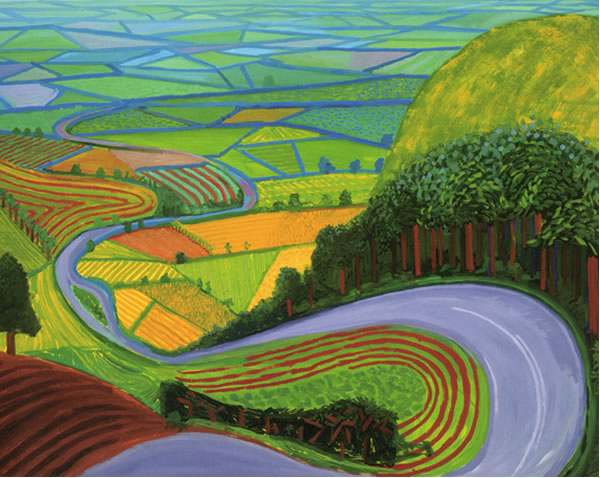
Garrowby Hill by David Hockney 1998
Is it really only April? I feel as if the Dalton Gathering
is upon me already as I meander through The Royal Academy studying the David
Hockney paintings and drawings of East Yorkshire. Is this area so beautiful
and does the countryside sport blue tree trunks and purple roads? The senses
are touched as I feel the Yorkshire Wolds through the eyes of the artist as
his imagination runs wild.
I look forward to us all meeting up in July when I hope the
weather will be bright, and I will be able to remember Hockney’s interpretation
of this relatively undiscovered part of Britain.





























